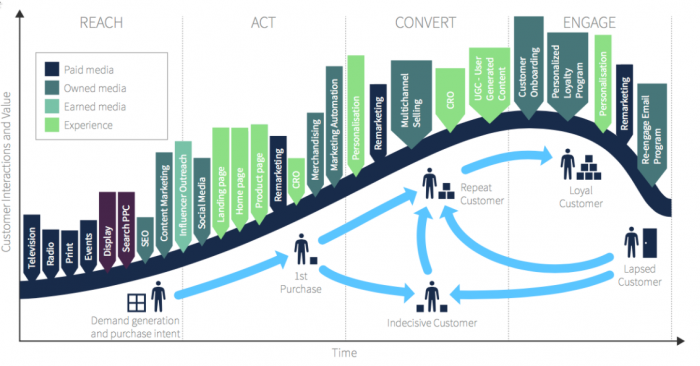The Email Marketing continues to be a vital communication channel. The annual DMA report states that with every email sent, corresponds on average a 30 times higher ROI. In the Report, 95% of the respondents said that they consider Email Marketing to be an “important” or a “very important” tool for their business.
That’s why 2018 will have once again one of its biggest challenges in the competition within the inbox.
SEO, PPC, advertising and Social Media will continue to bring customers to the narrowest point of the funnel but it is the Email Marketing that stimulates the entry into the funnel and helps keep ranking through repeated purchases and brand involvement.
Personalization, loyalty and re-engagement programs are essential for Email Marketing strategies and increase the response in all the prospect lifecycle touchpoints:

Although many of the techniques that will mostly contribute to our success in 2018 are not “new”, their use will be increased this year, improving the involved dynamics.
For example, the Email Marketing Census of Econsultancy and Adestra shows that the segmentation will remain the highest prerogative among the Email Marketing objectives.
Howsoever, the mobile optimization has the highest increase among the new methodological adoptions (+ 9%) demonstrating once again how important is this aspect for the engagement and retention on the on-the-go devices that require faster conversions.
Other methodologies leading to an increase of interest regard the encouragement of social sharing, greater attention to transactional emails and dynamic content based on location or other social feeds.
A well done customization is still the prerogative of a minority of companies, but the percentage of those who work to exploit the data for the benefit of more relevant content has experienced a positive increase: the emails sent on the basis of individual activities have gone from a 8 to 15%. The companies that adopt these methodologies agree (71%) that this leads to good or excellent performances.
In fact, those pursuing a strategy based on segmentation represent about twice the standard users with excellent returns on the investment.
The list segmentation is a requirement for the success, because it allows companies to deliver efficient messages by dividing prospects and consumers into different groups based on several factors such as location or product category to interact differently with their interests. This fundamental strategy allows marketing experts to move from a generalized approach of email marketing to a channel of communication more oriented to the measurement of individual needs.
Email Automation will continue its expansion to better open and click through rate. Interactive content and generally those based on gamification dynamics will become a guiding star that will lead marketers to play more with their readers.
In 2018, the tone of voice will shift towards an increasingly personal approach too, even in the B2B contexts that have always been bent to a certain formality: asking questions and starting a conversation with your audience is imperative to get involved, as well as transmitting tailored contents to your target.
An well known aspect that in 2018 will become even more categorical is related to security. The SPF and DKIM standards have more than a decade, while DMARC is newer, but all three – despite the pushes of the brands – see a relatively low adoption. Only 59.4% of the marketers adopted SPF, 66.6% DKIM and 46.5 DMARC. The BIMI standard (Brand Indicators for Message Identification) that will show the logo of the brand next to the authenticated messages will be one of the stimuli for the adjustment.
A real novelty for 2018 will be interactive emails, also known as “mailable microsites” that will allow recipients to interact with the message through integrated forms, surveys, search, menu options, countdowns, banners and more.
An interactive email will bring in the hands of its audience most of the useful contents for a campaign, raising the bar of engagement with the content. Also, the required costs in collecting data and building marketing personas can be reduced, thanks to the possibility of inserting surveys and other advanced profiling elements in the email.
The sending platforms are gradually embeding these features in the drag and drop editors, while for now this option seems to be more prerogative for the big companies, SMEs – the fulcrum in the use of Email Marketing – are empowering their activity here. And even if the statistics still describe the state of email marketing with data distorted by the possibilities of large companies, it is mainly the small and medium-sized companies that send daily millions of emails.
For us, the most interesting trend for 2018 is this new ability of SMEs to enhance their quality in Email Marketing. In the previous years they learned about the existence of the channel and its many advantages, including the high ROI. Today, SMEs have understood that the most efficient e-mail marketing is made up of valuable practices (A/B testing, multi channel campaigns, automated communication flows, …) and advanced profiling.

